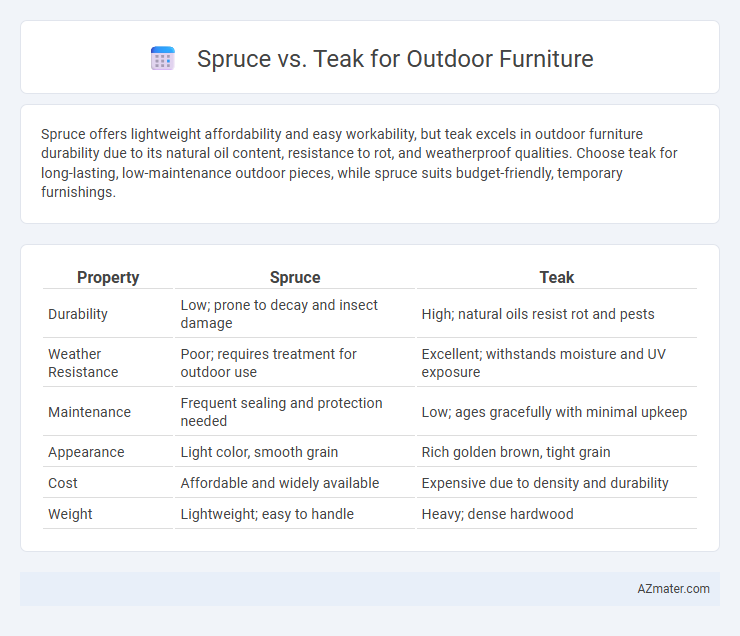Spruce offers lightweight affordability and easy workability, but teak excels in outdoor furniture durability due to its natural oil content, resistance to rot, and weatherproof qualities. Choose teak for long-lasting, low-maintenance outdoor pieces, while spruce suits budget-friendly, temporary furnishings.
Table of Comparison
| Property | Spruce | Teak |
|---|---|---|
| Durability | Low; prone to decay and insect damage | High; natural oils resist rot and pests |
| Weather Resistance | Poor; requires treatment for outdoor use | Excellent; withstands moisture and UV exposure |
| Maintenance | Frequent sealing and protection needed | Low; ages gracefully with minimal upkeep |
| Appearance | Light color, smooth grain | Rich golden brown, tight grain |
| Cost | Affordable and widely available | Expensive due to density and durability |
| Weight | Lightweight; easy to handle | Heavy; dense hardwood |
Introduction: Spruce vs Teak for Outdoor Furniture
Spruce and teak are popular wood choices for outdoor furniture, each offering distinct properties that influence durability and appearance. Spruce is lightweight and affordable but requires regular maintenance to resist moisture and pests. Teak, renowned for its natural oils and dense grain, provides exceptional weather resistance and longevity, making it ideal for outdoor use despite its higher cost.
Key Characteristics of Spruce Wood
Spruce wood, commonly used for outdoor furniture, is lightweight, moderately durable, and has a fine, even grain with a pale yellowish color that weathers to a silvery patina when exposed to sunlight. It is less dense and less naturally resistant to decay and insects compared to teak, requiring regular sealing or treatment to maintain its integrity and appearance outdoors. Spruce's affordability and ease of working make it a practical choice for budget-conscious projects, but it demands vigilant maintenance to ensure longevity in outdoor environments.
Key Characteristics of Teak Wood
Teak wood is renowned for its exceptional durability and natural resistance to water, insects, and decay, making it ideal for outdoor furniture. Its rich golden-brown color and dense grain provide both aesthetic appeal and structural strength, ensuring longevity even in harsh weather conditions. High oil content in teak further enhances its resistance to warping and cracking, outperforming softer woods like spruce in outdoor applications.
Durability and Weather Resistance Comparison
Teak offers superior durability and natural oils that provide exceptional resistance to weather, rot, and insects, making it ideal for long-lasting outdoor furniture. Spruce, while more affordable and lightweight, is less weather-resistant and requires regular treatment to prevent decay and damage from moisture exposure. For outdoor use in harsh climates, teak remains the preferred material due to its proven longevity and minimal maintenance requirements.
Maintenance Requirements: Spruce vs Teak
Spruce outdoor furniture requires frequent sealing and staining to protect against moisture and UV damage, ensuring longevity despite its softer wood structure. Teak boasts natural oils that provide exceptional resistance to rot, insects, and weather, making it low-maintenance with only occasional cleaning and oiling needed to preserve its rich golden color. Choosing teak significantly reduces long-term maintenance efforts compared to spruce, which demands more diligent upkeep to maintain durability and appearance.
Aesthetic Differences: Color, Grain, and Texture
Spruce outdoor furniture showcases a pale, creamy color with a fine, straight grain that presents a smooth and uniform texture, offering a clean and minimalist aesthetic. In contrast, teak features a rich golden-brown hue that deepens with age, characterized by a pronounced, wavy grain and naturally oily texture, adding warmth and a luxurious, rustic appeal to outdoor spaces. The visual differences in color richness, grain pattern complexity, and texture resilience make spruce ideal for modern, understated designs, while teak suits traditional and high-end outdoor furniture styles.
Cost Analysis: Spruce vs Teak Outdoor Furniture
Spruce outdoor furniture typically offers a more budget-friendly option due to its lower initial cost and faster growth rate, making it widely available and affordable. In contrast, teak furniture commands a higher price because of its dense, oil-rich wood that provides superior durability, weather resistance, and longevity. While spruce may require more frequent maintenance and replacement over time, teak's higher upfront investment often results in better long-term value and reduced upkeep expenses.
Sustainability and Environmental Impact
Spruce offers a renewable, fast-growing timber option with a lower carbon footprint due to its rapid growth cycle and widespread availability. Teak, while highly durable and resistant to weather, often raises sustainability concerns because it grows slowly and is frequently harvested from endangered tropical forests. Choosing FSC-certified spruce ensures responsible forestry management, minimizing environmental impact compared to teak sourced from unsustainable plantations or illegal logging.
Best Use Cases for Spruce and Teak Furniture
Spruce wood is best suited for budget-friendly outdoor furniture in covered or semi-covered areas due to its lightweight and decent weather resistance when properly treated. Teak excels in fully exposed outdoor environments because of its natural oils that provide exceptional durability, resistance to moisture, and insect-proof qualities. Spruce is ideal for casual patio sets and garden benches, while teak is preferred for high-end, long-lasting outdoor dining sets and loungers that withstand harsh weather conditions.
Conclusion: Choosing the Right Wood for Your Outdoor Space
Spruce offers affordability and lightweight properties suitable for budget-conscious outdoor furniture, but it requires regular maintenance to withstand weather elements. Teak's natural oils provide exceptional durability, resistance to rot, and a luxurious appearance, making it ideal for long-term investment despite a higher initial cost. Selecting the right wood depends on balancing budget, maintenance willingness, and desired lifespan for your outdoor space.

Infographic: Spruce vs Teak for Outdoor Furniture
 azmater.com
azmater.com